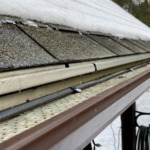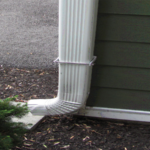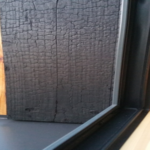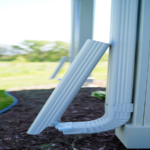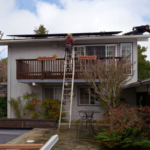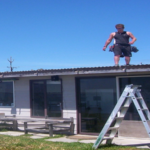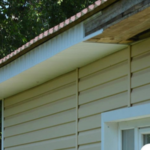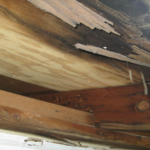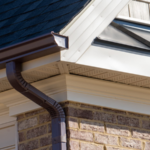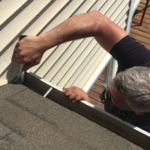The water that falls from the sky during a rainstorm is called precipitation. Most of this water is absorbed into the ground, where it becomes part of the groundwater supply. Some of it, however, flows over the land surface and eventually makes its way into lakes, rivers, and streams. And, yes, a small amount of it enters the sewer system.
There are two types of sewer systems: combined and separate. In a combined sewer system, both stormwater and wastewater from homes and businesses flow through the same pipes to a treatment plant. In a separate sewer system, stormwater is routed to a detention basin or other body of water, while wastewater goes to a treatment plant.
In either type of system, a small amount of precipitation will enter the sewer system through cracks in pipes, manhole covers, and other openings. In a separate sewer system, this water is routed to a treatment plant, where it undergoes the same treatment as wastewater. In a combined sewer system, the stormwater is mixed with wastewater and treated together.
How does rain water get into the sewer?
The vast majority of rainwater that falls on a city is drained away through a system of gutters, drains, and sewers. The water flows by gravity through a network of pipes to the treatment plant. In some areas, though, the sewers are combined, which means that they carry both rainwater runoff and sewage. During dry weather, the flow in a combined sewer is usually small and goes to the treatment plant without overloading the sewer system. However, during heavy rainfalls, the combined sewer system can become overloaded. When this happens, a mixture of rainwater and sewage flows back into homes and businesses through floor drains and toilet traps, or it may overflow from manholes in the street.
Where should rainwater drain to?
There are a few different options for where rainwater should drain to. One option is to let it drain into the street. This is not the best option, however, because it can lead to flooding and other problems. Another option is to let it drain into a storm sewer. This is a better option, because it will be taken away from your property and will not cause any problems. The best option, however, is to let it drain into a rain barrel or some other type of container. This way, you can use the rainwater for watering your plants or for other purposes.
Can rainwater go into soil pipe?
Yes, rainwater can enter into the soil pipe. However, the amount of water that can enter the soil pipe is determined by the diameter of the soil pipe. For example, a 4-inch diameter soil pipe can handle approximately four gallons of water per minute.
Can rain cause sewer to back up?
The short answer is yes, rain can most definitely cause your sewer to back up. When it rains, the water that falls from the sky doesn’t just disappear into the ground. A lot of it actually ends up in the sewer system, which is designed to carry away waste water from homes and businesses. However, the sewer system can only handle so much water at a time. If the system gets overloaded, then the water has nowhere to go but back up into your home or business through the drains. And that’s not a pleasant situation for anyone involved.
Can heavy rain cause toilets to back up?
Yes, heavy rain can cause toilets to back up. When it rains heavily, the water level in the sewer system can rise, causing a backup in the system. If the toilet is connected to the sewer system, the water can rise up and cause the toilet to back up.
Why do sewers overflow in heavy rain?
Sewers overflow during heavy rain because the stormwater runoff overwhelsts estimate that a one-inch rainstorm will generate about 700 gallons of water for every 100 square feet of roof area. Most of this water is discharged into storm drains and eventually finds its way into surface waters, such as rivers, lakes, and the ocean. A small portion of the water, however, infiltrates the ground and becomes groundwater.
During a rainstorm, the stormwater runoff from streets and parking lots carries a mixture of pollutants, including oil, grease, heavy metals, and bacteria, into storm drains. This polluted water is then discharged, untreated, into surface waters.
In addition, when it rains heavily, the volume of water in the sewers can exceed the capacity of the sewer system. This can cause the sewers to overflow, sending a mixture of stormwater and sewage into surface waters.
How do you get rid of rainwater?
There are a few things you can do to get rid of rainwater. One is to simply let it evaporate. You can also use a wet/dry vacuum to suck up the water. Another option is to use a mop and bucket to remove the water. Finally, you can use a sponge to soak up the water.
Can I discharge rainwater into a ditch?
Yes, you can discharge rainwater into a ditch as long as the ditch is not located on your neighbor’s property and is not a protected wetland. Discharging rainwater into a ditch can help to reduce flooding on your property and can also help to recharge groundwater aquifers.
How do you stop sewer backup from raining?
- Check your gutters and downspouts to ensure they are clean and free of debris.
- Check the area around your home for any potential sources of flooding, such as low-lying areas, ditches, or culverts.
- If you have a sump pump, make sure it is in good working order and that the discharge pipe is clear.
- If you live in an area prone to flooding, consider purchasing a backwater valve to help prevent sewage from backing up into your home.
- Be prepared to evacuate if necessary, and have a plan in place for where you would go and what you would need.
- Do not flush toilets or use any water fixtures in your home.
- Call your local utility company or a plumber to resolve the issue.
- If you must leave your home, turn off all utilities at the main breaker or valve.
- If possible, stay with a friend or relative who lives outside of the flooded area.
- When you return home, open windows and doors to air out your home and remove any standing water.
- Throw away any food that has come into contact with floodwaters.
- Wash all clothing and linens in hot water.
Conclusion
No, rain water cannot go into sewer. Rain water goes into the storm drain and then eventually into a river or the ocean.

